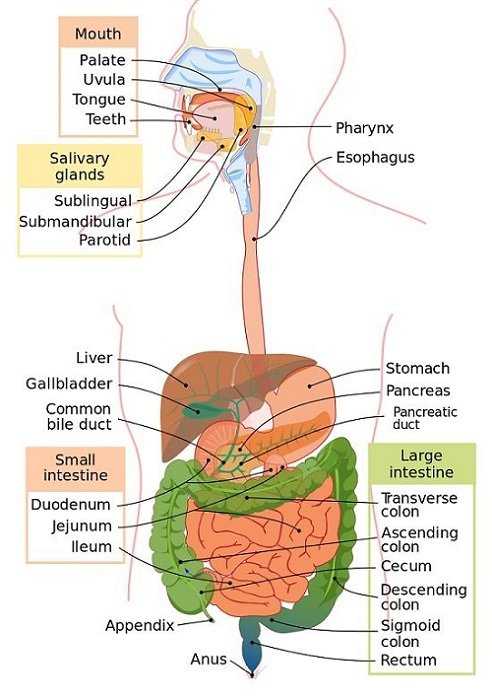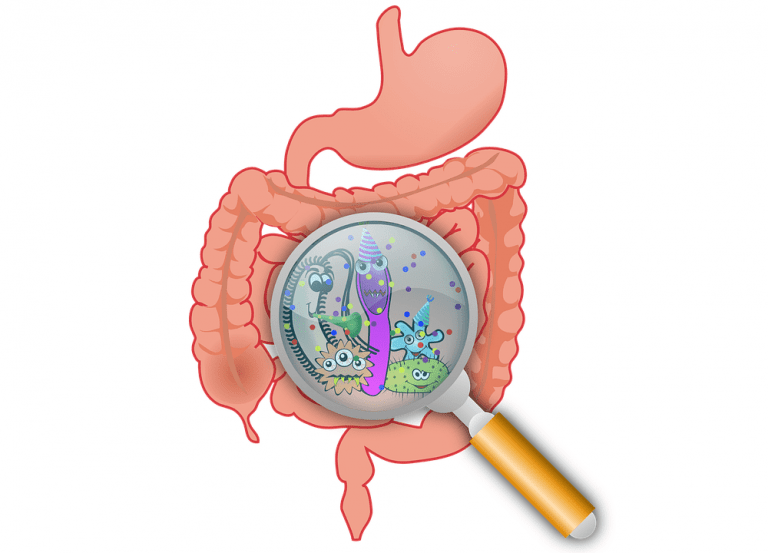Small intestinal bacterial overgrowth occurs in more than 60% of patients with abdominal pain. Small intestinal bacterial overgrowth (SIBO) is on the rise in children and it should be considered as one of the causes of chronic abdominal pain.
Understanding our digestive system and the role of the small intestines.

Source: https://biologydictionary.net/digestive-system/
It is important to understand how our digestive system works. After we put food in our mouths, it travels down to our oesophagus and enters the stomach. Thereafter food enters the small intestine, large intestine and rectum to eventually excrete any food contents that are no longer needed by our body.
During the process of digestion, the small intestine plays a critical role in performing as much as 90% of the digestion and absorption of food and its nutrients, whereas the remaining 10% is performed by the stomach and large intestine.
Gut flora the forgotten organ
We have over 100 trillion bacterial organisms in our gut. The range and species vary depending on the area of the gastrointestinal tract. While the large intestine has around 10-100 billion bacteria organisms per teaspoon of fluid, the small intestine only has around 100 thousand organisms.
When present in normal quantities, the bacteria (gut flora) is very important for our health.
Bacteria in the gut has numerous functions, including:
- Helping to break down carbohydrates so they can be absorbed
- Helping the gut’s immune system develop
- Protecting against disease-causing bacteria
- Stimulating the growth of the intestinal lining
- Producing vitamin K
In the event, that the normal function of the small intestine or any other part of the gastrointestinal (GI) tract is compromised, bacterial overgrowth can occur. This causes a wide range of harmful effects such as inhibit normal digestion of food and damage the lining of the small intestine.
What is SIBO?
Small intestine bacterial overgrowth (SIBO) is a condition in which there is an over-colonization of specific bacteria in the small intestines. It occurs because the bacteria which should be in your large intestine gets into your small intestines. The increased number of non-pathogenic bacteria of over 105 organisms can cause various uncomfortable symptoms.
SIBO in children has harmful consequences due to the malabsorption state it causes in the small intestine. This can lead to deficiencies in vitamins and minerals. SIBO impairs the intestinal absorption of fats, proteins, carbohydrates, and fat-soluble vitamins. Depriving a child of these nutrients affects the child’s growth and development.
Dr. Nirala Jacobi (BHSc, ND) is the leading expert in the treatment of SIBO and in this interview, she discusses “SIBO and Children” with Dr. Megan Taylor. You can check her entire playlist on youtube
Symptoms
The primary symptoms of SIBO include:
- Abdominal bloating
- Belching
- Gas
- Abdominal pain
- Cramping
- Constipation and/or diarrhoea
Leaky gut symptoms are also a big sign of SIBO. Leaky gut, or “intestinal permeability” is a condition in which the lining of the small intestine becomes damaged, causing undigested food particles, toxic waste products and bacteria to “leak” through the intestines and flood the bloodstream.
- Multiple food sensitivities- fructose, gluten, lactose
- Headaches
- fatigue
- skin issues
- mood issues
- asthma
- joint pain
- nutritional deficiencies
- weight loss,
- Loss of appetite
- Steatorrhea (fatty stools)
Causes Of SIBO
Early life risk factors
Development of the intestinal microbiome begins at birth. It involves an exchange of microbes between mother and child. However, birth by C-sections and antibiotics during pregnancy alter the infant microbiome. After birth, maternal breast milk promotes the colonization and maturation of the infant gut microbiome. Opting for Formula feeding will not provide the infant with the essential gut microbiomes. This predisposes a child to dysbiosis which can lead to SIBO in the early years of childhood.
Pre-existing health conditions
Several pre-existing health conditions may predispose children to SIBO.
- Gut motility disorders: The ileocecal valve is what separates the large and small intestines. In conditions with slow motility, this valve can get weak or held open which allows for bacteria to translocate from the large to the small intestine. Improving gut motility is of upmost importance in preventing and correcting SIBO.
- Abnormal thyroid function: Hypothyroidism has been associated with altered GI motility resulting in SIBO.
- Mitochondrial disorders decrease small intestine motility, causing food and ingested bacteria to stagnate, which may promote bacterial overgrowth.
- Lowered immunity may also predispose children to SIBO by disrupting normal immune mechanisms in the intestine that keep bacterial counts in balance.
Overuse of pharmaceutical drugs
Over use of Pharmaceutical drugs, including antibiotics, proton pump inhibitors, and H2 receptor blockers, are linked to the development of SIBO in children. Antibiotics can wipe out the beneficial bacteria in the gut. This can lead to gut dysbiosis. Proton pump inhibitors (PPIs) and H2 receptor blockers decrease stomach acid secretion. This increases the chance of SIBO because Hydrochloric (HCL) is needed to suppress the growth of bad bacteria. Research has shown that even after a short use of PPIs as well as reflux and colic medication can increase the chance of children developing SIBO.
Testing Methods
Breath tests
The hydrogen breath test (HBT) is the gold standard non-invasive measurement of SIBO.
Although there is evidence supporting the utility of breath tests for SIBO diagnosis in adults and older children, they are not reliable in young children under the age of 5 due to inadequate breath collection and rapid gut transit thus giving rise to false-positive results.
Small Bowel Aspirate
This test is an invasive test where a tube is placed through the nose, into the stomach, until it reaches the small intestine, where a small amount of fluid is aspirated (removed). This fluid is cultured to determine what bacteria are present. Additionally, research indicated that this method only reveals 10% of the microbiota in the small intestine. Due to the inconsistent occurrence of SIBO throughout the small intestine, aspirate may fail to adequately measure the overgrowth occurring in other areas of the small intestine, distal to the test site location. Lastly, certain bacterial species within the small intestine cannot be effectively cultured. For these reasons it has fallen out of favour and is not commonly used in clinical practice to diagnose SIBO.
Stool Tests
Stool tests such as the complete digestive stool analysis can show signs of SIBO such as fat malabsorption and bacterial composition changes in the colon. Additionally, stool testing can be used to rule out parasites, measure inflammation levels in the large intestine, and measure levels of yeast in the large intestine. Stool testing can provide us with useful information about the current state of digestion as well as the microbiome of the large intestines and if there is any e-coli or non-e-coli bacterial overgrowth.
Urine Organic Acid Testing
Testing the urine for organic acids can show signs of systemic yeast/bacteria in the body and indicate the presence of bacterial overgrowth. This is also known as the OAT test. However, this test cannot show where the bacterial overgrowth is occurring and is therefore not considered to be a specific or accurate test for diagnosing SIBO.
Treatment
Antibiotics
The antibiotic Rifaximin is an effective and safe treatment for SIBO. However, antibiotics come with its side effects. Taking antibiotics may get rid of the overgrowth temporarily, but they can upset the gut flora balance and the “bad” bacteria is just likely to colonise again causing recurrence of SIBO.
Herbal Treatment
Herbal medicine such as biocidin is the best option for children. This is a plant-based herbal antibiotic that targets the whole GI tract. It supports microbiome balance for healthy digestion and elimination.It is a longer treatment of up to 12 weeks but has shown to be very effective on children with SIBO.
Diet
Diets used for SIBO is primarily focused on decreasing polysaccharides, oligosaccharides and disaccharides via the elimination of all grains, starchy vegetables, lactose, and sweeteners other than honey. Legumes are eliminated initially. It has been found that using the Specific Carbohydrate Diet (SCD) or its variant, the Gut and Psychology Syndrome diet (GAPS) as the core diet, with the incorporation of the fruit and vegetable recommendations from the Low FODMAP diet is an effective approach.
As a mom, it’s important to be well-informed about what food, drinks, and supplements are ideal for maintaining gut health in children. Knowing you have full control over your child’s nutritional input is comforting, but ensuring you’re doing it right can also be overwhelming.
Thankfully, finding the information you need is pretty easy when you have an abundance of resources on pediatric nutrition. Learn more about what’s best for your kids from this definitive guide on improving gut health through adequate dietary intake so you can make more educated decisions for their well-being.
And finally, aid your research with a professional consultation with a specialist in child nutrition to have a more rounded understanding of the topic
Low FODMAP Diet
Research indicates that a low FODAMP diet can reduce symptoms of SIBO such as abdominal pain. FODMAPs stands for Fermentable, Oligo-, Di-, Mono-saccharides, and Polyols. FODMAPs are found in many common foods. These Carbohydrates are known to cause digestive discomfort in certain individuals. Following a low FODMAP diet can reduce symptoms pf gas, bloating and abdominal pain and also help in treating SIBO. When following a Low FODMAP diet for your child it is important to work closely with a pediatric dietitian so that you are still ensuring your child gets a balanced diet. It should be considered as a short-term approach only.
Supplements
Hydrochloric Acid
Betaine hydrochloride or herbal bitter supplements such as apple cider vinegar or lemon juice should be used to increase the production of hydrochloric acid and bile. The correct amount of Hydrochloric acid is essential to kill off bad bacteria.
Digestive enzymes
Take a good digestive enzyme which will support your digestion. It is especially useful if you have a leaky gut. Digestive enzymes, especially proteases and lipases, are an important protective factor against SIBO. The insufficient output of digestive enzymes from the pancreas is associated with many symptoms associated with SIBO and may represent a key underlying factor in many cases. Enzymedica is the leading brand when it comes to enzymes. Check out their Digest Spectrum product enzyme.
Probiotics
If you have SIBO it is important to note that your regular probiotic may increase your symptoms. Many individuals with SIBO struggle with any lactobacillus strains of bacteria especially the strains that produce lactic acid can make your symptoms worse. However, it doesn’t mean that you should avoid probiotics altogether. You need probiotics to restore the good bacteria.
Therefore, the best probiotics whilst treating SIBO is the soil based probiotics.
Soil-based probiotics have a natural, seed-like structure. This makes it withstand stomach acid, bile salts, and pancreatic enzymes that would normally destroy the bacteria.
Soil based probiotics are Bacillus clausi, Bacillus coagulans, and Bacillus subtilis. They do not colonise the small intestines and straight go into the large intestines and colon. Check out Garden of Life Ultimate Probiotic Formula or Primal Defense for Kids
Diatomaceous earth (Food grade)
Diatomaceous earth (DE) is a powder that is largely made up of a chemical compound called silica. It is highly absorbed and attracts protozoa, bacteria, toxins, fungi, viruses and heavy metals and eliminates them. DE is now commonly used for SIBO treatment and is ideal for children. This product comes in powder form and can easily be added into your child’s food.
Vagus nerve stimulation
Vagus nerve stimulation (VNS) is a medical treatment that involves delivering electrical impulses to the vagus nerve. It is used as an add-on treatment for certain conditions and may prevent SIBO recurrence especially in older children.
Plenty of physical activity and drinking warm water
Ensure your child has plenty of physical activity as it will help with better digestion. Always give your child warm water to drink. Warm water will help break down foods even faster, making them easier for you to digest.
SIBO and Salicylates
SIBO and/or dysbiosis can lead to salicylate intolerance. Salicylates are a subset of phenols that are found in many vegetables and fruits and medications.
SIBO causes leaky gut or gut permeability causing malabsorption. This can lead to salicylate intolerance.
The crucial role of minerals in salicylate treatment
You need to have enough alkaline minerals such as calcium, magnesium and potassium in your body to be able to cope with the salicylates that are in the fruits and vegetables you are consuming. Whilst treating SIBO it is important to keep your body in an alkaline state by supplementing with the alkaline mineral such as calcium, magnesium and potassium.
You can use urine strips to check the acidity in your urine. The first-morning urine gives you the best indication of the acidity. You can take Sodium bicarb (electrolyte mixtures) to counter the acidity in the urine and buffer the toxicity. Keep your salt intake to a minimum. The best salt to use is Himalayan pink salt.
Detoxification Pathways
As part of the treatment, it is important to address your phase II liver detoxification pathways. This is called the conjugation pathway, whereby the liver cells add another substance (Eg: cysteine, glycine or a sulphur molecule) to a toxic chemical or drug, to render it less harmful. This makes the toxin or drug water-soluble, so it can then be excreted from the body via watery fluids such as bile or urine.
Phase II pathways to address are
Glucuronidation: Glucuronidation is literally a process in which glucuronic acid is conjugated (joined) to various toxins in the liver so that they can be excreted through the bile or urine. Calcium D Glucerate is a supplement that addresses this pathway. It can reduce toxicity in the body.
Sulfation: The phenol sulphotransferase (PST) sulfation pathway is necessary for the breakdown and removal of certain toxins in the body. This includes the processing of salicylates. Methyl Sulfonyl Methane (MSM) supplement is a sulfur/methyl donor that helps accelerate healing and “detox” the body by improving how chemicals enter and leave our cells. It will support the sulfation pathway.
Glycination: Salicylates and benzoates are detoxified primarily through glycination. Benzoate is present in many food substances and is widely used as a food preservative. Many other substances are detoxified as well via the glycine conjugation pathway. It has been seen that amylase enzyme together with Glycine reduces the effect of salicylic acid and counteracts salicylate intolerance symptoms fast and effectively.
Diet resources for salicylate sensitive patients
It is important to note that the low FODMAP diet includes salicylate containing food. Thus, when moving on to the FODMAP diet to eradicate SIBO you need to also take into consideration the salicylate food guide.
Water quality and pH requirements for best digestive health. In some countries the water supply is too acidic. Water quality and its PH levels are an important factor to consider for best digestive health.
L-glutamine powder: It is a powerful amino acid that helps repair gut lining by rebuilding the affected cells caused by SIBO.
Omega 3 and zinc:Other key nutrients for gut repair are omega-3 fish oils, Zinc and herbs such as deglycyrrhizinated licorice (DGL) and aloe vera.
Global Warming and its effect on salicylates
Planetary stress such as global warming is having an impact on the natural salicylate production in plants. The plants tend to naturally produce more salicylate to protect themselves from the changing environment.
Dr.Nirala Jacobi speaks with DR. Donna Beck on salicylate sensitivity a condition implicated by SIBO. You can view the podcast here.
SIBO is becoming more and more prevalent in children. If your child has had chronic abdominal pain, test for SIBO. Treat and eliminate it soon and don’t let SIBO takeover your child’s health by disrupting their growth and development.
If you are struggling with food intolerances, allergies, SIBO or other digestive problems, there are products that can help with symptom relief. I know it can be frustrating but there are treatment protocols and supplements which can really help.
I have designed this product guide to equip you with the best and most effective supplements you can buy for treatment as well as symptom relief. This list has been compiled through my own experience as well as working together with trusted and experienced practitioners.
You can check out my recommended supplement guide here.



3 Comments
This article gives a great insight into SIBO and treatment options. We have just started SIBO treatment for my son who has been having chronic abdominal pain. Will be trying some of the supplements mentioned here.
Can abdominal pain above the belly button be a symptom of SIBO? My son has no bloating, but a bad pain in his upper abdomen.
Sorry to hear about your son. Constant abdominal pain can be due to one/many conditions. My suggestion would be to get a SIBO (Hydrogen/Methane) Breath Test done as soon as possible. It will tell whether you’re son has SIBO and if so whether it’s hydrogen or methane dominant. Treatment plan varies accordingly. Where are you based? We opted for a naturopathic type of treatment plan once we got the test done. Good luck and hope you find out what it is soon